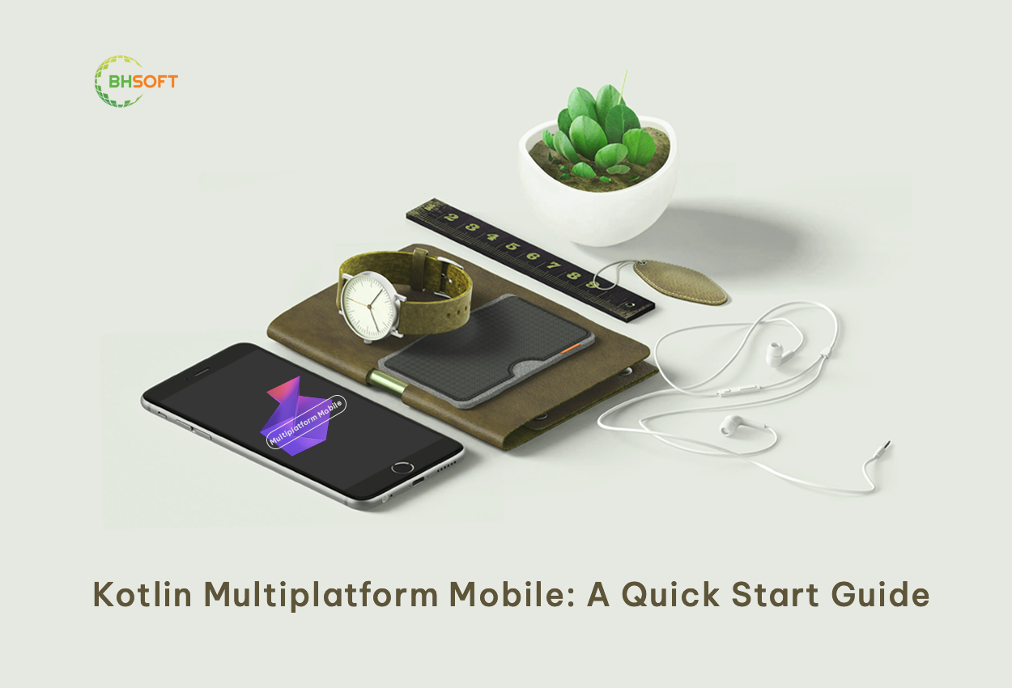Kotlin Multiplatform Mobile: A Quick Start Guide
5 minutes read
Audio description available
February 26, 2023
In commercial mobile development projects, there is often limited time for experimentation. Developers need to find tools and technologies that provide value to the product, but they also need to grow their skills. One solution is to use a small library that facilitates code sharing across platforms. This can be a great way to learn a new technology that directly benefits the project. And this is where Kotlin Multiplatform Mobile comes into play—it strikes a perfect balance between exploration and tangible gains.

What Is Kotlin Multiplatform Mobile?
Kotlin Multiplatform Mobile (KMM) is a framework developed by JetBrains, the creators of the Kotlin programming language. It allows developers to write shared code in Kotlin that can be utilized across multiple platforms.
By sharing business logic across platforms, you unlock several advantages:
- Faster development time
- Streamlined code maintenance
- Increased flexibility
- Native performance optimization
- Seamless access to platform-specific code
- Single set of tests applicable to all platforms
Currently, JavaScript, iOS, Android, and even desktop applications can all run KMM.
Kotlin Multiplatform Mobile primarily targets the Android and iOS platforms. It provides a plugin that integrates with Android Studio, enabling you to conveniently run and debug iOS code within the same environment. Additionally, KMM offers the flexibility to share code across various other platforms, including JavaScript, desktop (Windows, Linux, Mac), JVM, and more. This versatility empowers developers to maximize code reuse and extend their applications to multiple target platforms.
What Can Kotlin Multiplatform Mobile Do?
Kotlin Multiplatform Mobile, though still in alpha, offers developers stable building blocks. KMM offers access to reliable and thoroughly tested libraries that enable various functionalities such as performing HTTP requests, building databases, and accessing local files and app settings. With KMM's libraries, developers can implement a data access layer, write code and tests once, and distribute it across multiple platforms as needed.
Moreover, up to 85% of the code can be shared between platforms by structuring code appropriately. This includes sharing everything from the data access layer (Interactors/UseCases) to the data presentation layer (ViewModel). If you are already utilizing Clean Architecture with one of the MV* presentation patterns, transitioning to KMM becomes a seamless process.
How to Start Working in Kotlin Multiplatform Mobile?
One of the most significant advantages of this technology is its versatility, allowing you to explore it in various ways.
Firstly, you can dive in by building a basic app that demonstrates code sharing between platforms. Numerous KMM samples available online can guide you through the process. Additionally, you have the option to create and distribute a library that encapsulates specific logic utilized in your project.
Another approach is to select a portion of your existing app and convert it into a multiplatform application. If your app is already modularized, integrating Kotlin Multiplatform Mobile will be a seamless endeavor.
How to Distribute Libraries Written in Kotlin Multiplatform Mobile
Distributing libraries written in Kotlin Multiplatform Mobile (KMM) involves a series of important steps.
Firstly, the library needs to be packaged into a distributable format, such as a JAR or an AAR file, which contains the compiled code and necessary resources. Versioning and metadata, including information about the library's purpose, author, and dependencies, should also be provided. Once packaged, the library can be published to a repository hosting platform, such as Maven Central or JitPack, making it easily accessible to other developers. To ensure successful adoption, comprehensive documentation should be created, offering clear instructions on installation, usage, and API references.
Additionally, including sample projects or code snippets can help showcase practical integration scenarios. For streamlining the release process, setting up a continuous integration and deployment pipeline can automate the build, testing, and publishing of new library versions.
By following these steps, libraries written in Kotlin Multiplatform Mobile can be effectively distributed, promoting code reuse and facilitating collaboration within the Kotlin community.
Testing App Performance with Kotlin Multiplatform Mobile
An organized testing process is required to ensure that your Kotlin Multiplatform Mobile (KMM) app performs at its best on all platforms.
Begin by establishing a performance benchmark as a reference point for comparison. Conduct platform-specific testing on Android and iOS to identify any platform-specific bottlenecks or issues. Perform load testing to evaluate performance under heavy workloads and stressful conditions. Utilize profiling and instrumentation tools to gather detailed performance data, including CPU usage, memory allocation, and network requests. Simulate real-world scenarios to uncover any performance issues that may arise in different usage environments. Implement continuous performance monitoring to track performance over time and address any regressions.
By diligently testing and optimizing app performance with KMM, you can deliver a high-performing app experience to users across various platforms.
Who is using Kotlin Multiplatform Mobile?
Kotlin Multiplatform Mobile, despite being new, has already made a solid foothold in the tech stacks of some of the most well-known brands in the world.
Netflix

Kotlin Multiplatform Mobile is used by Prodicle, a Netflix app for creating videos, to create cross-platform business logic. Netflix selected KMM in order to enhance delivery times using multiplatform architecture.
JetBrains

The creators of Kotlin and KMM themselves, JetBrains actively utilizes KMM in their own projects and provides ongoing development and support for the framework.
Conclusion
The alpha stage of Kotlin Multiplatform Mobile (KMM) signifies that it is still undergoing active development and refinement and has not yet reached its full potential. While KMM has shown promising potential and gained traction in the developer community, it's important to note that its readiness for production may depend on various factors, including the specific requirements of your project and the stability of the KMM framework at the time of use.
As a trusted software company, BHSoft provides top multiplatform mobile development services. By utilizing latest technologies, such as React Native, Flutter, and Kotlin, we develop dynamic mobile applications that operate smoothly across different platforms and devices. Our goal is to maximize user experience so that your app stands out in the market.
To make your mobile app a reality, get in touch with us today.
